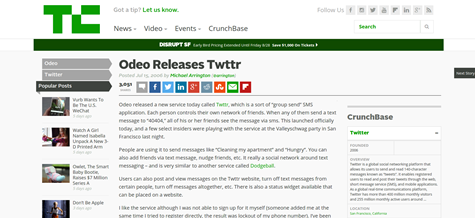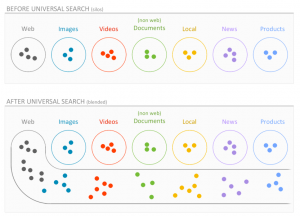
Whether you’re starting a blog or starting a company, stiff competition is a common setback to success.
Founders need to be agile and flexible to stand out from the crowd… and sometimes that flexibility results in surprising changes.
From Nokia’s roots in 19th century Finland, to Groupon’s evolution from idealistic social project to paragon of capitalism, these companies had to make some big changes to achieve success, taking advantage of opportunities as they arose.
Here are some key lessons we can learn from their successful pivots – and how you can incorporate their tactics into your own blog to replicate their success.
1. Watch Your Niche & Differentiate
Not many Twitter users today know that the microblogging service was actually a spinoff product from a podcast startup called Odeo, founded in 2005 by Noah Glass. Odeo was a podcast directory that also provided Flash-based tools for users to create and share their own podcasts through the website.
While Odeo was a modest success and attracted some funding in its early days, it became clear to the founders that it wasn’t going to dominate the podcasting niche like they’d hoped. “We were facing tremendous competition from Apple and other heavyweights,” wrote Dom Sagolla, an Odeo employee who worked on the podcasting software.
They knew Odeo would never be the game-changing success they dreamed of, so they started holding hackathons to come up with a novel idea for a new product.
During one of these hackathons, Jack Dorsey came up with the idea for Twttr. It was launched publicly in 2006, and today its 300 million active users send about 500 million tweets per day on average.
Watch the Big Players in Your Blogging Niche
Twitter never would have been created if its founders hadn’t been keeping an eye on other companies in the podcasting space, and their own position within the industry.
Do you know who the big players are in your blogging niche? What other blogs do your readers subscribe to, and how does yours measure up?
Be sure to subscribe to the popular and influential bloggers in your niche. By keeping an eye on what they’re doing, you can get ideas for how to stand out from the crowd.
2. Listen to Your Audience
Today Groupon has 50 million active customers who purchase deals from the website, but most of those users wouldn’t recognize its humble beginnings.
Groupon started out as a website called The Point, a social media platform for social good. As its founder Andrew Mason explained:
“It was a platform for groups of people to come together and say, ‘I’ll do something but only if enough other people do it with me.’ It could be used for raising money. For political campaign. For some kind of charitable cause. It could be used for a collective action thing like organizing a boycott or organizing an event of some sort. Trying to solve the problems associated with getting a group of people, a problem that is too big for one person to solve alone, that requires the commitment of a group of people and everybody not being willing to take that step because they don’t think there’s enough other people along with them.”
While a noble idea, The Point wasn’t much of a money maker.
One of his biggest mistakes, he said, was “[not] letting the users tell us if it worked or not. That’s the biggest lesson that I learned as part of that project.”
When some of The Point’s users started getting together to try to get group discounts on products, Mason’s investors saw the potential.
In 2008, Groupon was launched as a spinoff, and eventually outgrew The Point completely.
Listen to Your Blog Readers

How much do you interact with and listen to your own blog audience? They’ll let you know what kind of content they want.
Groupon was only launched because the founders learned to listen to their users and pay attention to how they were actually using the site, instead of just following their own plans.
How much do you interact with and listen to your own audience?
Do you know which blog posts are your most popular, what kinds of content your readers want more of, or what difficulties they’re having with your website?
You can start listening to and learning from your audience by:
- Reading and responding to all blog post comments
- Interacting with your readers on social media
- Conducting surveys on your website or email newsletter
- Personally emailing your subscribers to thank them and ask their needs
- Taking a closer look at your website analytics
3. …But not too much
When TechCrunch announced Twttr’s launch in 2006, the article attracted quite a lot of negative predictions:

When Odeo first announced the launch of Twttr, it garnered a lot of negative comments.
“Not innovative and not focused. Twttr sounds like a disaster in the making.”
“This is NEVER going to catch on.”
“I think this is the dumbest thing ever! Who would want all their personal text messages on a public website for anyone to read and track?”
Take Negative Feedback With a Grain of Salt
If the Odeo employees working on the new project had listened to that feedback, Twitter might never have had the chance to take off like it did.
Don’t be afraid to run with your ideas for your blog, even if you’re the only one who believes in it at first. It’s normal to get negative feedback whenever you implement big changes, but they may prove to be successful in the end despite the naysayers.
4. Steal Ideas From Unlikely Sources
There might be a Starbucks on every corner today, but back in the 80s they were just a small Seattle chain selling espresso makers, coffee beans, and other coffee equipment.
After a trip to Italy in 1983, new marketing director Howard Schultz fell in love with European-style coffeehouses, and was determined to mimic the experience back in the states. By 2007, Starbucks had become a nationwide sensation, with 15,000 stores across the United States.
Gather Inspiration and Capture All Your Ideas

There wouldn’t be a Starbucks on every corner today if Schultz had never gotten inspired by Italy.
As a seller of coffee equipment, Schultz could’ve stuck with selling equipment and gotten inspiration from other equipment sellers or just businesses in his local area. Instead, he traveled the globe and was inspired by a different type of business halfway around the world.
When it comes to your own blog, don’t just focus on those who are closest to you. Try subscribing to blogs on all different topics for ideas, or gleaning inspiration from art, books, TV shows, movies, concerts, and other mediums.
Capture ideas by carrying a notebook with you everywhere you go. Anytime you come across something that captures your attention, stop and think about it. How can you replicate that feeling on your own blog, for your own audience?
5. Narrow Your Focus to Grow Your Authority
Both Nokia and Nintendo, though famous for their modern technological achievements, were actually founded in the 1800s as very different businesses than they are now.
Nintendo was founded in 1889 as a card company, specializing in a handmade playing card game called Hanafuda, while Nokia was a paper mill founded in 1865 in Finland.
Throughout the 19th and 20th centuries, Nintendo dabbled in different ventures: starting a taxi company, a love hotel chain, a TV network, and a food company selling instant rice, before they got into making video games in the 70s.
Nokia branched out from paper to manufacturing rubber goods and various electronics and telecommunications devices in the 1900s, before creating their first mobile phone in 1992.
Focus on Your Successes
Nokia and Nintendo could have kept pursuing their other product lines, but instead they focused on the hugely successful ones. As a result, that’s what they’re famous for.
Bloggers, too, know that when you’re a jack of all trades, you’re a master of none.
Are you trying to be too much of a generalist on your blog? Maybe it’s time to choose a focus.
Take a look at your most successful and popular posts. If your readers are really responding to certain posts, and not others, maybe it’s time to focus on those type of posts exclusively, and make a name for yourself in your specialty.
6. Try New Ideas to Promote Your Blog
Wrigley didn’t always sell gum – in fact, they used to give it away for free.
William Wrigley Jr. was a soap and baking powder salesman in the 1890s, and promoted his product by offering free gum with every purchase. But when his gum got to be more popular than his actual products, he decided to focus on manufacturing gum instead.
The makeup company Avon had a similar start, with a traveling book salesman named David H. McConnell, who gave away free perfume samples with his books, before realizing his customers clamored for perfume more than books. He dropped his books and began recruiting women to sell his perfume, believing that they’d relate to his female customers better.
Both companies tried different ideas to promote their products, and ended up learning a lot about their audience in the process.
In your blog, try incorporating freebies to entice email subscribers, or incorporating content upgrades. One day, your freebies could turn into your most popular offerings – maybe even a publishing deal or another source of income.
Ready For Your Own Blog Pivot?
Have these famous business pivots sparked ideas for your own blog? Or maybe you’ve already changed blog directions in the past? Share your successful blog pivots in the comments!
Digital & Social Articles on Business 2 Community(100)
Report Post






